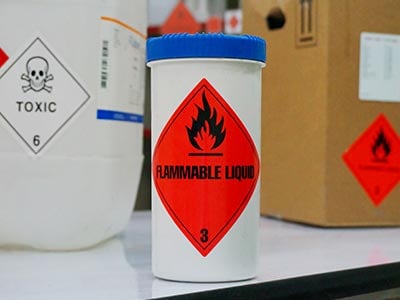The International Trade Blog Export Forms
What You Need to Know about Shipping Dangerous Goods
On: August 21, 2019 | By:  David Noah |
4 min. read
David Noah |
4 min. read
 In 2014, a South Korean shipper incurred a $72,000 fine for non-compliant packaging and labeling on a shipment of paints and solvents. Around the same time, an Ohio-based distribution company failed to appropriately label packages and complete shipping paperwork for an air shipment of corrosive wood cleaner and paid $63,000 for its negligence.
In 2014, a South Korean shipper incurred a $72,000 fine for non-compliant packaging and labeling on a shipment of paints and solvents. Around the same time, an Ohio-based distribution company failed to appropriately label packages and complete shipping paperwork for an air shipment of corrosive wood cleaner and paid $63,000 for its negligence.
Shipping dangerous goods is a complex and highly regulated process, and it can be difficult, for a variety of reasons, to get compliance buy-in from everyone in your company involved with the shipping process. However, as many businesses have discovered, non-compliance with International Air Transport Association (IATA) and DOT regulations is expensive.
How do you properly protect your business and employees from costly hazmat regulations violations?
Dangerous Goods Definition
According to IATA, dangerous goods (DGs) are “articles or substances which are capable of posing a risk to health, safety, property or the environment, and which are shown in the list of dangerous goods in these Regulations or which are classified according to these Regulations.”
The IATA FAQ page explains in more helpful words that they are “items that may endanger the safety of an aircraft or persons on board the aircraft…[and] are also known as restricted articles, hazardous materials, and dangerous cargo. Many common items found in your household can be considered dangerous goods for the purpose of air transport.” (For a more comprehensive discussion of the definition of dangerous goods, see our blog post, Hazardous Materials vs. Dangerous Goods: What's the Difference?)
Dangerous Goods: Classified
Both the U.S. Department of Transportation (DOT) and the international regulatory agencies recognize nine classes of dangerous goods:
Class 1: Explosives
- Fireworks, airbag inflators, ammunition, etc.
Class 2: Gases
- Aerosols, fire extinguishers, propane cylinders, etc.
Class 3: Flammable liquids
- Paints, lacquers, alcohols, etc.
Class 4: Flammable solids, spontaneous combustibles, and “dangerous when wet” materials
- Matches, carbon, sodium batteries, etc.
Class 5: Oxidizers
- Hydrogen peroxide, ammonium nitrate fertilizers, pool chlorine, etc.
Class 6: Toxic or infectious substances
- Medical waste, dyes, pesticides, etc.
Class 7: Radioactive materials
- Density gauges, medical treatment products, uranium, etc.
Class 8: Corrosives
- Acids/acid solutions, batteries, iodine, etc.
Class 9: Miscellaneous
- Dry ice, internal combustion engines, first aid kits, etc.
Many of these classes are divided into sub-classifications according to various properties such as temperature sensitivity (also known as flash point), toxicity, and flammability.
Dangerous Goods: Packaged and Labeled
Here’s where the rubber meets the road for exporters: Every class of materials has both national and international packing and marking/placarding specifications. The CFR49 requires that every employee involved in dangerous goods packaging and shipping receive hazmat training in handling, packing, labeling and documenting dangerous goods for transport. (Failure to train employees is itself considered a violation of regulations.)
There are three packing groups corresponding to the level of danger involved:
- Packing Group I (indicated by the letter “X” in shipping codes)—Great Danger
- Packing Group II (indicated by a “Y”)—Medium Danger
- Packing Group III (indicated by a “Z”)—Minor Danger
Each of the packing group provides specifications for unit-size, quantitative limits, packaging closure instructions, acceptable packaging materials, single or combination-packaging limitations, and more.
Once proper packaging is complete, the package must be labeled and placarded appropriately. Each dangerous goods class has designated signage including, among other things, color-coding, warning placards, and directional indicators.
Dangerous Goods: Documentation Guidance
Once packing and labeling requirements have been met, the appropriate documentation forms required for the given modes of transportation (air, ground, and sea) must be completed. This final, essential step verifies the qualitative and quantitative details of the shipments and declares that the shipment is compliance with both international and national requirements.
The complexity and specificity of the shipping process and necessary forms can be intimidating, but thankfully, there are resources available to help you every step of the way.
Resources for Shipping Dangerous Goods
Watch the free one-hour webinar, An Introduction to Shipping Dangerous Goods, for more in-depth coverage of the basic topics we’ve addressed. It provides basic step-by-step documentation instruction for some of the most common forms, and frees you from some of the angst or intimidation that can accompany the compliance conversation.
Once you've watched the webinar, check out our free 12-minute video that shows you how you can use Shipping Solutions Professional export documentation and compliance software to quickly create the IATA and IMO dangerous goods forms. Better yet, schedule a free online demo of the software to see how Shipping Solutions can meet your company's specific needs. There's no obligation!

About the Author: David Noah
As president of Shipping Solutions, I've helped thousands of exporters more efficiently create accurate export documents and stay compliant with import-export regulations. Our Shipping Solutions software eliminates redundant data entry, which allows you to create your export paperwork up to five-times faster than using templates and reduces the chances of making the types of errors that could slow down your shipments and make it more difficult to get paid. I frequently write and speak on export documentation, regulations and compliance issues.


